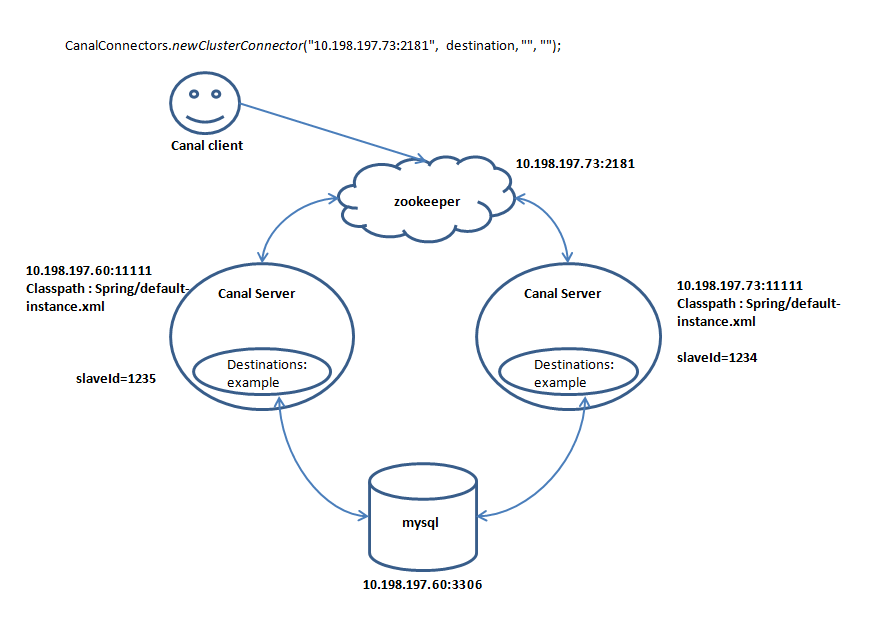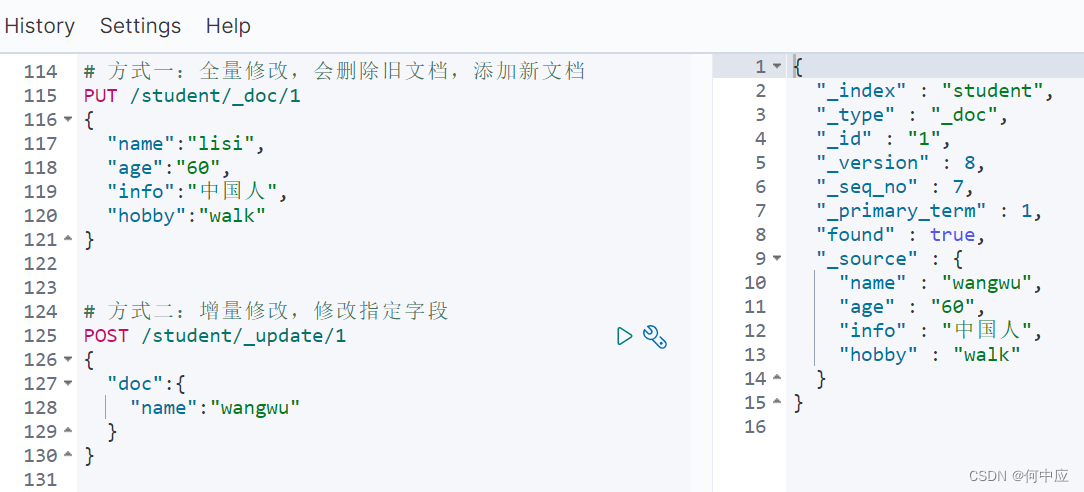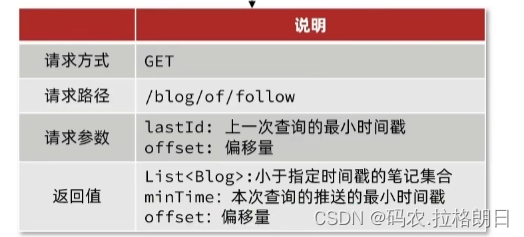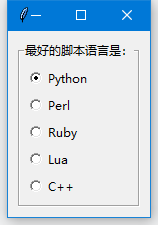day02
day02KeepAlived高可用集群配置高可用的web集群监控本机80端口,实现主备切换实现原理实施配置高可用、负载均衡的web集群配置高可用、负载均衡HAProxy配置haproxy负载均衡调度器比较LVS(Linux Virtual Server)NginxHAProxy
KeepAlived高可用集群
- keepalived用于实现高可用集群
- 它的工作原理就是VRRP(虚拟冗余路由协议)
配置高可用的web集群


-
环境说明:
- web1:eth0->192.168.88.100/24
- web2:eth0->192.168.88.200/24
-
配置keepalived
# 在两台web服务器上安装keepalived
[root@pubserver cluster]# vim 07-install-keepalived.yml
---
- name: install keepalived
hosts: webservers
tasks:
- name: install keepalived # 安装keepalived
yum:
name: keepalived
state: present
[root@pubserver cluster]# ansible-playbook 07-install-keepalived.yml
# 修改配置文件
[root@web1 ~]# vim /etc/keepalived/keepalived.conf
12 router_id web1 # 设置本机在集群中的唯一识别符
13 vrrp_iptables # 自动配置iptables放行规则
... ...
20 vrrp_instance VI_1 {
21 state MASTER # 状态,主为MASTER,备为BACKUP
22 interface eth0 # 网卡
23 virtual_router_id 51 # 虚拟路由器地址
24 priority 100 # 优先级
25 advert_int 1 # 发送心跳消息的间隔
26 authentication {
27 auth_type PASS # 认证类型为共享密码
28 auth_pass 1111 # 集群中的机器密码相同,才能成为集群
29 }
30 virtual_ipaddress {
31 192.168.88.80/24 # VIP地址
32 }
33 }
# 删除下面所有行
[root@web1 ~]# systemctl start keepalived
# 等几秒服务完全启动后,可以查看到vip
[root@web1 ~]# ip a s eth0 | grep '88'
inet 192.168.88.100/24 brd 192.168.88.255 scope global noprefixroute eth0
inet 192.168.88.80/24 scope global secondary eth0
# 配置web2
[root@web1 ~]# scp /etc/keepalived/keepalived.conf 192.168.88.200:/etc/keepalived/
[root@web2 ~]# vim /etc/keepalived/keepalived.conf
12 router_id web2 # 改id
13 vrrp_iptables
... ...
20 vrrp_instance VI_1 {
21 state BACKUP # 改状态
22 interface eth0
23 virtual_router_id 51
24 priority 80 # 改优先级
25 advert_int 1
26 authentication {
27 auth_type PASS
28 auth_pass 1111
29 }
30 virtual_ipaddress {
31 192.168.88.80/24
32 }
33 }
# 启动服务
[root@web2 ~]# systemctl start keepalived
# 查看地址,eth0不会出现vip
[root@web2 ~]# ip a s | grep '88'
inet 192.168.88.200/24 brd 192.168.88.255 scope global noprefixroute eth0
# 测试,现在访问88.80,看到是web1上的内容
[root@client1 ~]# curl http://192.168.88.80
Welcome from web1
# 模拟web1出现故障
[root@web1 ~]# systemctl stop keepalived.service
# 测试,现在访问88.80,看到是web2上的内容
[root@client1 ~]# curl http://192.168.88.80
Welcome from web2
# 在web2上查看vip,可以查看到vip 192.168.88.80
[root@web2 ~]# ip a s | grep '88'
inet 192.168.88.200/24 brd 192.168.88.255 scope global noprefixroute eth0
inet 192.168.88.80/24 scope global secondary eth0
监控本机80端口,实现主备切换
实现原理
- 配置高可用的web集群时,Keepalived只为服务器提供了VIP
- Keepalived不知道服务器上运行了哪些服务
- MASTER服务器可以通过跟踪脚本监视本机的80端口,一旦本机80端口失效,则将VIP切换至BACKUP服务器
- Keepalived对脚本的要求是,退出码为0表示访问成功;退出码为1表示失败。
实施
# 1. 在MASTER上创建监视脚本
[root@web1 ~]# vim /etc/keepalived/check_http.sh
#!/bin/bash
ss -tlnp | grep :80 &> /dev/null && exit 0 || exit 1
[root@web1 ~]# chmod +x /etc/keepalived/check_http.sh
# 2. 修改MASTER配置文件,使用脚本
[root@web1 ~]# vim /etc/keepalived/keepalived.conf
1 ! Configuration File for keepalived
2
3 global_defs {
...略...
18 }
19
20 vrrp_script chk_http_port { # 定义监视脚本
21 script "/etc/keepalived/check_http.sh"
22 interval 2 # 脚本每隔2秒运行一次
23 }
24
25 vrrp_instance VI_1 {
26 state MASTER
27 interface eth0
28 virtual_router_id 51
29 priority 100
30 advert_int 1
31 authentication {
32 auth_type PASS
33 auth_pass 1111
34 }
35 virtual_ipaddress {
36 192.168.88.80/24
37 }
38 track_script { # 引用脚本
39 chk_http_port
40 }
41 }
# 3. 重起服务
[root@web1 ~]# systemctl restart keepalived.service
# 4. 测试,关闭web1的nginx后,VIP将会切换至web2
[root@web1 ~]# systemctl stop nginx.service
[root@web1 ~]# ip a s | grep 88
inet 192.168.88.100/24 brd 192.168.88.255 scope global noprefixroute eth0
[root@web2 ~]# ip a s | grep 88
inet 192.168.88.200/24 brd 192.168.88.255 scope global noprefixroute eth0
inet 192.168.88.80/24 scope global secondary eth0
# 5. 当MASTER的nginx修复后,VIP将会切换回至web1
[root@web1 ~]# systemctl start nginx.service
[root@web1 ~]# ip a s | grep 88
inet 192.168.88.100/24 brd 192.168.88.255 scope global noprefixroute eth0
inet 192.168.88.80/24 scope global secondary eth0
[root@web2 ~]# ip a s | grep 88
inet 192.168.88.200/24 brd 192.168.88.255 scope global noprefixroute eth0
配置高可用、负载均衡的web集群
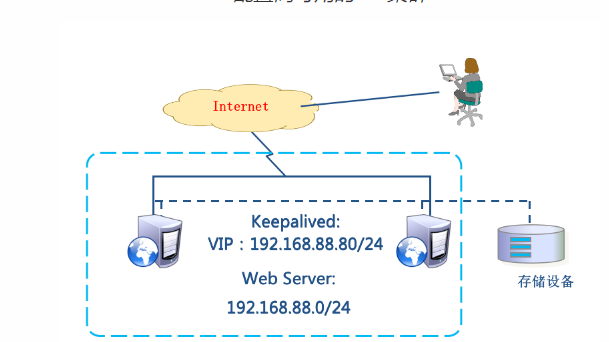

-
环境说明:LVS-DR模式
- client1:eth0->192.168.88.10
- lvs1:eth0->192.168.88.5
- lvs2:eth0->192.168.88.6
- web1:eth0->192.168.88.100
- web2:eth0->192.168.88.200
-
环境准备
# 关闭2台web服务器上的keepalived,并卸载
[root@pubserver cluster]# vim 08-rm-keepalived.yml
---
- name: remove keepalived
hosts: webservers
tasks:
- name: stop keepalived # 停服务
service:
name: keepalived
state: stopped
- name: uninstall keepalived # 卸载
yum:
name: keepalived
state: absent
[root@pubserver cluster]# ansible-playbook 08-rm-keepalived.yml
# 创建新虚拟机lvs2
[root@myhost ~]# vm clone lvs2
# 为lvs2设置ip地址
[root@myhost ~]# vm setip lvs2 192.168.88.6
# 连接
[root@myhost ~]# ssh 192.168.88.6
配置高可用、负载均衡
- 在2台web服务器的lo上配置vip
- 在2台web服务器上配置内核参数
- 删除lvs1上的
eth0上的VIP地址。因为vip将由keepalived接管
[root@pubserver cluster]# vim 09-del-lvs1-vip.yml
---
- name: del lvs1 vip
hosts: lvs1
tasks:
- name: rm vip
lineinfile: # 在指定文件中删除行
path: /etc/sysconfig/network-scripts/ifcfg-eth0
regexp: 'IPADDR2=' # 正则匹配
state: absent
notify: restart system
handlers:
- name: restart system
shell: reboot
[root@pubserver cluster]# ansible-playbook 09-del-lvs1-vip.yml
# 查看结果
[root@lvs1 ~]# ip a s eth0 | grep 88
inet 192.168.88.5/24 brd 192.168.88.255 scope global noprefixroute eth0
- 删除lvs1上的lvs规则。因为lvs规则将由keepalived创建
[root@lvs1 ~]# ipvsadm -Ln # 查看规则
[root@lvs1 ~]# ipvsadm -D -t 192.168.88.15:80
- 在lvs上配置keepalived
# 在主机清单文件中加入lvs2的说明
[root@pubserver cluster]# vim inventory
...略...
[lb]
lvs1 ansible_host=192.168.88.5
lvs2 ansible_host=192.168.88.6
...略...
# 安装软件包
[root@pubserver cluster]# cp 01-upload-repo.yml 10-upload-repo.yml
---
- name: config repos.d
hosts: lb
tasks:
- name: delete repos.d
file:
path: /etc/yum.repos.d
state: absent
- name: create repos.d
file:
path: /etc/yum.repos.d
state: directory
mode: '0755'
- name: upload local88
copy:
src: files/local88.repo
dest: /etc/yum.repos.d/
[root@pubserver cluster]# ansible-playbook 10-upload-repo.yml
[root@pubserver cluster]# vim 11-install-lvs2.yml
---
- name: install lvs keepalived
hosts: lb
tasks:
- name: install pkgs # 安装软件包
yum:
name: ipvsadm,keepalived
state: present
[root@pubserver cluster]# ansible-playbook 11-install-lvs2.yml
[root@lvs1 ~]# vim /etc/keepalived/keepalived.conf
12 router_id lvs1 # 为本机取一个唯一的id
13 vrrp_iptables # 自动开启iptables放行规则
... ...
20 vrrp_instance VI_1 {
21 state MASTER
22 interface eth0
23 virtual_router_id 51
24 priority 100
25 advert_int 1
26 authentication {
27 auth_type PASS
28 auth_pass 1111
29 }
30 virtual_ipaddress {
31 192.168.88.15 # vip地址,与web服务器的vip一致
32 }
33 }
# 以下为keepalived配置lvs的规则
35 virtual_server 192.168.88.15 80 { # 声明虚拟服务器地址
36 delay_loop 6 # 健康检查延迟6秒开始
37 lb_algo wrr # 调度算法为wrr
38 lb_kind DR # 工作模式为DR
39 persistence_timeout 50 # 50秒内相同客户端调度到相同服务器
40 protocol TCP # 协议是TCP
41
42 real_server 192.168.88.100 80 { # 声明真实服务器
43 weight 1 # 权重
44 TCP_CHECK { # 通过TCP协议对真实服务器做健康检查
45 connect_timeout 3 # 连接超时时间为3秒
46 nb_get_retry 3 # 3次访问失败则认为真实服务器故障
47 delay_before_retry 3 # 两次检查时间的间隔3秒
48 }
49 }
50 real_server 192.168.88.200 80 {
51 weight 2
52 TCP_CHECK {
53 connect_timeout 3
54 nb_get_retry 3
55 delay_before_retry 3
56 }
57 }
58 }
# 以下部分删除
# 启动keepalived服务
[root@lvs1 ~]# systemctl start keepalived
# 验证
[root@lvs1 ~]# ip a s eth0 | grep 88
inet 192.168.88.5/24 brd 192.168.88.255 scope global noprefixroute eth0
inet 192.168.88.15/32 scope global eth0
[root@lvs1 ~]# ipvsadm -Ln # 出现规则
IP Virtual Server version 1.2.1 (size=4096)
Prot LocalAddress:Port Scheduler Flags
-> RemoteAddress:Port Forward Weight ActiveConn InActConn
TCP 192.168.88.15:80 wrr persistent 50
-> 192.168.88.100:80 Route 1 0 0
-> 192.168.88.200:80 Route 2 0 0
# 客户端连接测试
[root@client1 ~]# for i in {1..6}; do curl http://192.168.88.15/; done
Welcome from web2
Welcome from web2
Welcome from web2
Welcome from web2
Welcome from web2
Welcome from web2
# 为了效率相同的客户端在50秒内分发给同一台服务器。为了使用同一个客户端可以看到轮询效果,可以注释配置文件中相应的行后,重启keepavlied。
[root@lvs1 ~]# vim +39 /etc/keepalived/keepalived.conf
...略...
# persistence_timeout 50
...略...
[root@lvs1 ~]# systemctl restart keepalived.service
# 在客户端验证
[root@client1 ~]# for i in {1..6}; do curl http://192.168.88.15/; done
Welcome from web2
Welcome from web1
Welcome from web2
Welcome from web2
Welcome from web1
Welcome from web2
# 配置LVS2
[root@lvs1 ~]# scp /etc/keepalived/keepalived.conf 192.168.88.6:/etc/keepalived/
[root@lvs2 ~]# vim /etc/keepalived/keepalived.conf
12 router_id lvs2
21 state BACKUP
24 priority 80
[root@lvs2 ~]# systemctl start keepalived
[root@lvs2 ~]# ipvsadm -Ln # 出现规则
IP Virtual Server version 1.2.1 (size=4096)
Prot LocalAddress:Port Scheduler Flags
-> RemoteAddress:Port Forward Weight ActiveConn InActConn
TCP 192.168.88.15:80 wrr
-> 192.168.88.100:80 Route 1 0 0
-> 192.168.88.200:80 Route 2 0 0
- 验证
# 1. 验证真实服务器健康检查
[root@web1 ~]# systemctl stop nginx
[root@lvs1 ~]# ipvsadm -Ln # web1在规则中消失
[root@lvs2 ~]# ipvsadm -Ln
[root@web1 ~]# systemctl start nginx
[root@lvs1 ~]# ipvsadm -Ln # web1重新出现在规则中
[root@lvs2 ~]# ipvsadm -Ln
# 2. 验证lvs的高可用性
[root@lvs1 ~]# shutdown -h now # 关机
[root@lvs2 ~]# ip a s | grep 88 # 可以查看到vip
inet 192.168.88.6/24 brd 192.168.88.255 scope global noprefixroute eth0
inet 192.168.88.15/32 scope global eth0
# 客户端访问vip依然可用
[root@client1 ~]# for i in {1..6}; do curl http://192.168.88.15/; done
Welcome from web1
Welcome from web2
Welcome from web2
Welcome from web1
Welcome from web2
Welcome from web2
HAProxy
-
也是一款实现负载均衡的调度器
-
适用于负载特别大的web站点
-
HAProxy的工作模式:
- mode http:只适用于web服务
- mode tcp:适用于各种服务
- mode health:仅做健康检查,很少使用
配置haproxy
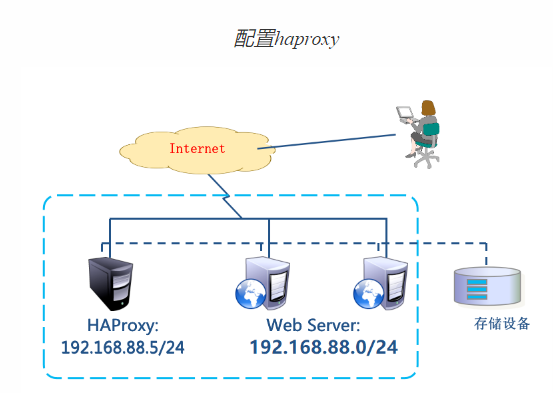

-
环境准备:
- client1:eth0 -> 192.168.88.10
- HAProxy:eth0 -> 192.168.88.5
- web1:eth0 -> 192.168.88.100
- web2:eth0 -> 192.168.88.200
-
初始化配置
# 关闭192.168.88.6
[root@lvs2 ~]# shutdown -h now
# 配置192.168.88.5为haproxy服务器
[root@pubserver cluster]# vim 12-config-haproxy.yml
---
- name: config haproxy
hosts: lvs1
tasks:
- name: rm lvs keepalived # 删除软件包
yum:
name: ipvsadm,keepalived
state: absent
- name: rename hostname # 修改主机名
shell: hostnamectl set-hostname haproxy1
- name: install haproxy # 安装软件包
yum:
name: haproxy
state: present
[root@pubserver cluster]# ansible-playbook 12-config-haproxy.yml
# web服务器,不需要配置vip,不需要改内核参数。但是存在对haproxy也没有影响。
- 配置haproxy
# 修改配置文件
[root@haproxy1 ~]# vim /etc/haproxy/haproxy.cfg
# 配置文件中,global是全局配置;default是缺省配置,如果后续有和default相同的配置,default配置将会被覆盖。
# 配置文件中,frontend描述haproxy怎么和用户交互;backend描述haproxy怎么和后台应用服务器交互。这两个选项,一般不单独使用,而是合并到一起,名为listen。
# 将64行之后全部删除,写入以下内容
64 #---------------------------------------------------------------------
65 listen myweb # 定义虚拟服务器
66 bind 0.0.0.0:80 # 监听在所有可用地址的80端口
67 balance roundrobin # 定义轮询调度算法
# 对web服务器做健康检查,2秒检查一次,如果连续2次检查成功,认为服务器是健康的,如果连续5次检查失败,认为服务器坏了
68 server web1 192.168.88.100:80 check inter 2000 rise 2 fall 5
69 server web2 192.168.88.200:80 check inter 2000 rise 2 fall 5
70
71 listen stats # 定义虚拟服务器
72 bind 0.0.0.0:1080 # 监听在所有可用地址的1080端口
73 stats refresh 30s # 设置监控页面自动刷新时间为30秒
74 stats uri /stats # 定义监控地址是/stats
75 stats auth admin:admin # 监控页面的用户名和密码都是admin
# 启服务
[root@haproxy1 ~]# systemctl start haproxy.service
# 使用firefox访问监控地址 http://192.168.88.5:1080/stats
# 客户端访问测试
[root@client1 ~]# for i in {1..6}; do curl http://192.168.88.5/; done
Welcome from web2
Welcome from web1
Welcome from web2
Welcome from web1
Welcome from web2
Welcome from web1
# client1上使用ab访问
[root@client1 ~]# yum install -y httpd-tools
[root@client1 ~]# ab -n1000 -c200 http://192.168.88.5/
监控地址 http://192.168.88.5:1080/stats如下:
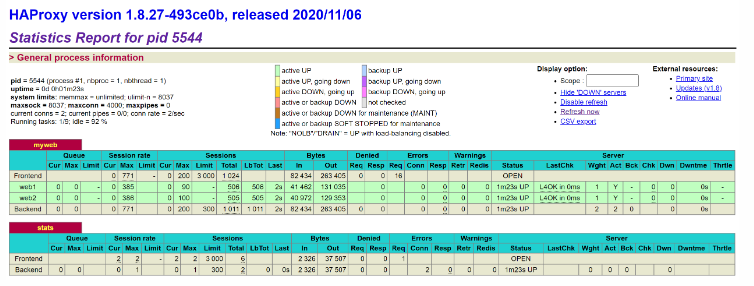

- Queue:队列长度。Cur当前队列长度,Max最大队列长度,Limit限制长度
- Session rate:会话率,每秒钟的会话数
- Sessions:会话数
- Bytes:字节数。In收到的字节数,Out发出的字节数
- Denied:拒绝。Req请求,Resp响应
- Errors:错误
- Warning:警告
- Status:状态
- LastChk:上一次检查。L4OK,第四层tcp检查通过
- Wght:权重
负载均衡调度器比较
LVS适用于需要高并发性和稳定性的场景,Nginx适用于静态文件服务和反向代理等应用层负载均衡场景,HAProxy则具备较为丰富的功能和灵活性,适用于多种负载均衡场景。
LVS(Linux Virtual Server)
优点:
- 高性能:LVS使用Linux内核中的IP负载均衡技术,能够实现非常高的并发处理能力。
- 稳定性:LVS经过长时间的实践应用,成熟稳定,被广泛使用。
- 可用性:支持高可用性的配置,可以实现故障自动切换,提供无中断的服务。
- 灵活性:可根据需要采用多种负载均衡算法,如轮询、加权轮询、哈希等。
缺点:
- 配置复杂:相对于其他两个技术,LVS的配置相对较为复杂,需要更深入的了解和配置。
- 功能相对局限:LVS主要是一种传输层负载均衡技术,无法像Nginx和HAProxy那样对应用层协议进行处理。
Nginx
优点:
- 高性能:Nginx采用了基于事件驱动的异步非阻塞架构,能够处理大量并发连接。
- 负载均衡:Nginx具备内置的负载均衡功能,可以根据配置进行请求的转发。
- 丰富的功能:Nginx支持反向代理、静态文件服务、缓存、SSL等,在Web服务器领域有很广泛的应用。
缺点:
- 功能相对较少:相对于LVS和HAProxy,Nginx在负载均衡算法和健康检查等方面的功能相对较少。
- 限制于应用层协议:Nginx只能对HTTP和HTTPS等应用层协议进行处理,无法处理其他协议。
HAProxy
优点:
- 灵活性:HAProxy支持丰富的负载均衡算法和会话保持方式,可以根据需求进行灵活配置。
- 完整的功能:HAProxy支持高可用性配置、健康检查、故障恢复、SSL等功能,在负载均衡领域应用广泛。
- 高性能:HAProxy性能优良,能够处理大量并发连接,并且支持异步IO模型。
缺点:
- 内存占用:相对于Nginx和LVS,HAProxy在处理大量连接时消耗的内存稍高一些。
- 高可用性:HAProxy需要借助额外的工具来实现高可用性,例如Keepalived。
知识点思维导图:https://flowus.cn/share/7875c0e1-ebbd-4dad-aa7e-f40e6ed6c6d3





